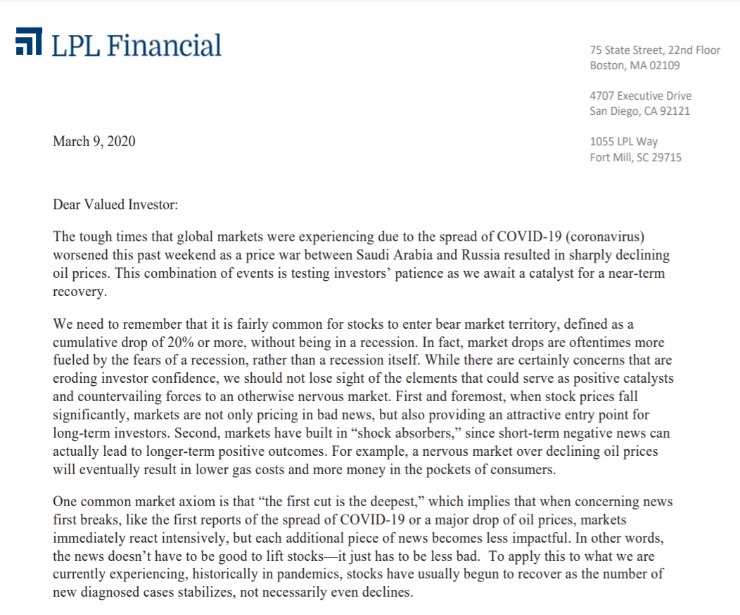The tough times that global markets were experiencing due to the spread of COVID-19 (coronavirus) worsened this past weekend as a price war between Saudi Arabia and Russia resulted in sharply declining oil prices. This combination of events is testing investors’ patience as we await a catalyst for a near-term recovery.
We need to remember that it is fairly common for stocks to enter bear market territory, defined as a cumulative drop of 20% or more, without being in a recession. In fact, market drops are oftentimes more fueled by the fears of a recession, rather than a recession itself. While there are certainly concerns that are eroding investor confidence, we should not lose sight of the elements that could serve as positive catalysts and countervailing forces to an otherwise nervous market. First and foremost, when stock prices fall significantly, markets are not only pricing in bad news, but also providing an attractive entry point for long-term investors. Second, markets have built in “shock absorbers,” since short-term negative news can actually lead to longer-term positive outcomes. For example, a nervous market over declining oil prices will eventually result in lower gas costs and more money in the pockets of consumers.
One common market axiom is that “the first cut is the deepest,” which implies that when concerning news first breaks, like the first reports of the spread of COVID-19 or a major drop of oil prices, markets immediately react intensively, but each additional piece of news becomes less impactful. In other words, the news doesn’t have to be good to lift stocks—it just has to be less bad. To apply this to what we are currently experiencing, historically in pandemics, stocks have usually begun to recover as the number of new diagnosed cases stabilizes, not necessarily even declines.
In times like these, our natural inclination can be to sell. We are wired to flee when facing tough times. But we know this difficult environment—while scary for all of us—is temporary. History has taught us that rampant volatility creates opportunities—we experienced this in 2008, 2011, 2016, and most recently, in December 2018. These volatile times are when market prices disconnect from their underlying fundamentals. When this occurs, invariably the best decision for long-term investors has been to stay the course.
Though it can be difficult to focus on the long term at times like these, we believe this is one of those situations where eventually we will look back at it as a unique opportunity. Envisioning ourselves in that position in the future isn’t easy right now. It was hard to see green shoots in 2008, when few could envision the emergence of a positive market coming out of the financial crisis. Those who sell in a market storm rarely notice when the storm clouds begin to lift. And, as investors, missing those stock market rebounds is perhaps the biggest risk to achieving our long-term goals.
We don’t know exactly when this market will find a bottom and reverse course. Markets are facing a crisis of confidence. But, our confidence in the long-term fundamentals and prospects for the US economy and corporate America is unwavering. We will get through this. We believe patience will be rewarded.
Please contact your financial professional with questions.
Click here to download a PDF of this report.
This material is for general information only and is not intended to provide specific advice or recommendations for any individual. There is no assurance that the views or strategies discussed are suitable for all investors or will yield positive outcomes. Investing involves risks including possible loss of principal. Any economic forecasts set forth may not develop as predicted and are subject to change.
References to markets, asset classes, and sectors are generally regarding the corresponding market index. Indexes are unmanaged statistical composites and cannot be invested into directly. Index performance is not indicative of the performance of any investment and do not reflect fees, expenses, or sales charges. All performance referenced is historical and is no guarantee of future results.
All information is believed to be from reliable sources; however, LPL Financial makes no representation as to its completeness or accuracy
This research material has been prepared by LPL Financial LLC.
Securities and advisory services offered through LPL Financial (LPL), a registered investment advisor and broker‐dealer (member FINRA/SIPC).
Insurance products are offered through LPL or its licensed affiliates. To the extent you are receiving investment advice from a separately registered independent investment advisor that is not an LPL affiliate, please note LPL and makes no representation with respect to such entity.
If your advisor is located at a bank or credit union, please note that the bank/credit union is not registered as a broker-dealer or investment advisor. Registered representatives of LPL may also be employees of the bank/credit union. These products and services are being offered through LPL or its affiliates, which are separate entities from, and not affiliates of, the bank/credit union. Securities and insurance offered through LPL or its affiliates are:
Not Insured by FDIC/NCUA or Any Other Government Agency | Not Bank/Credit Union Guaranteed Not Bank/Credit Union Deposits or Obligations | May Lose Value
Tracking #1- 962339 (Exp. 03/21)
